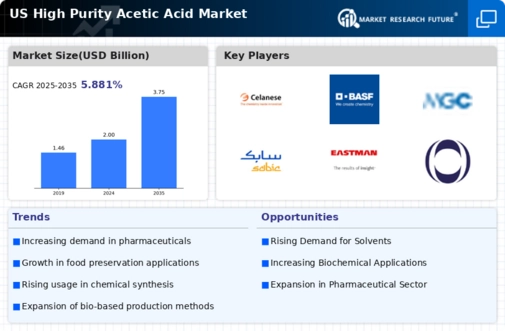Growth in Chemical Synthesis
The high purity-acetic-acid market is poised for growth due to its critical role in chemical synthesis processes. High purity acetic acid serves as a key reagent in the production of various chemicals, including acetic anhydride and acetate esters, which are essential in the manufacture of solvents, plastics, and pharmaceuticals. The chemical synthesis sector has been expanding, with a projected growth rate of around 5% annually, driven by increasing demand for specialty chemicals. This growth is likely to bolster the high purity-acetic-acid market, as manufacturers seek reliable and high-quality inputs for their production processes. The versatility of high purity acetic acid in chemical synthesis applications indicates a promising outlook for the market, as it continues to be a vital component in the development of innovative chemical products.
Increasing Industrial Applications
The high purity-acetic-acid market is experiencing a notable surge in demand due to its increasing applications across various industrial sectors. Industries such as textiles, plastics, and food processing are utilizing high purity acetic acid for its solvent properties and as a chemical intermediate. For instance, the textile industry employs high purity acetic acid in the production of synthetic fibers, which has seen a growth rate of approximately 4.5% annually. This trend indicates a robust expansion in the market, as manufacturers seek high-quality inputs to enhance product performance. Furthermore, the food industry utilizes high purity acetic acid as a food preservative and flavoring agent, further driving its consumption. As industries continue to evolve, the high purity-acetic-acid market is likely to benefit from these expanding applications.
Rising Demand for Specialty Chemicals
The high purity-acetic-acid market is benefiting from the rising demand for specialty chemicals, which are increasingly utilized in various applications, including coatings, adhesives, and sealants. As industries focus on developing high-performance products, the need for high purity acetic acid as a solvent and chemical intermediate is becoming more pronounced. The specialty chemicals market is projected to grow at a rate of approximately 6% annually, driven by advancements in technology and increasing consumer preferences for high-quality products. This trend suggests that the high purity-acetic-acid market will likely see a corresponding increase in demand, as manufacturers seek to enhance product formulations and meet evolving market needs. The interplay between specialty chemicals and high purity acetic acid underscores the market's potential for sustained growth.
Technological Innovations in Production
The high purity-acetic-acid market is experiencing transformative changes due to technological innovations in production processes. Advances in manufacturing techniques, such as improved catalytic processes and purification methods, are enabling producers to achieve higher purity levels and reduce production costs. These innovations not only enhance the quality of high purity acetic acid but also increase production efficiency, which is crucial in a competitive market. As companies adopt these technologies, the high purity-acetic-acid market is likely to benefit from increased supply and reduced prices, making it more accessible to various industries. Furthermore, the emphasis on sustainable production methods may lead to the development of greener technologies, further enhancing the market's appeal. Overall, these technological advancements are expected to play a pivotal role in shaping the future of the high purity-acetic-acid market.
Regulatory Compliance and Quality Standards
The high purity-acetic-acid market is significantly influenced by stringent regulatory compliance and quality standards imposed by various governing bodies. In the US, the Food and Drug Administration (FDA) and the Environmental Protection Agency (EPA) enforce regulations that necessitate the use of high purity acetic acid in food and pharmaceutical applications. These regulations ensure that products meet safety and quality benchmarks, thereby increasing the demand for high purity variants. As a result, manufacturers are compelled to invest in high-quality production processes to comply with these standards, which may lead to an increase in production costs. However, this compliance is essential for maintaining market access and consumer trust, suggesting that the high purity-acetic-acid market will continue to thrive as companies prioritize quality and safety.

















Leave a Comment